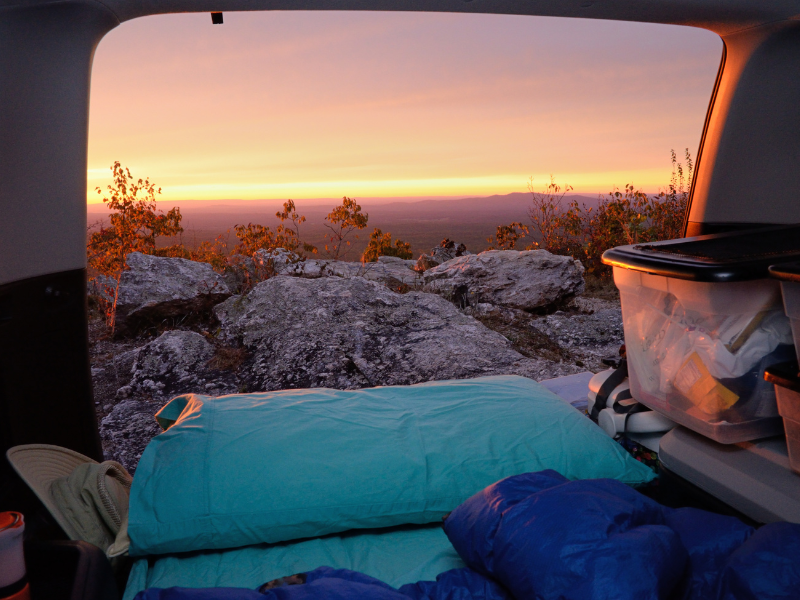Getting a good night’s sleep is key to having a great outdoor adventure experience, and choosing the right sleeping pad camping can make a difference.
A high-quality sleeping pad is vital in ensuring comfort, insulation, and support, preventing the aches and discomfort from sleeping on uneven or cold ground. Whether it’s a self-inflating pad, an air mattress, or a foam pad, choosing the right one can significantly impact the overall camping experience.
Camping with family is quite different from going solo or with just one other person. When you have multiple people to think about, things like space, ease of setup, and durability become very important. Parents need to keep their kids' needs in mind to ensure they stay warm and comfortable all night long.
Keep reading for essential information on the different types, what to consider when choosing one, and some helpful tips to enhance both comfort and durability, along with product recommendations.
Types
Self-Inflating
These pads combine foam and air to provide excellent comfort and insulation. They are easy to use, requiring minimal effort to inflate. Simply open the valve, and the pad expands on its own.
-
Pros: Comfortable, good insulation, easy to inflate.
-
Cons: Bulkier than other options, can be expensive.

Air Mattresses
Air mattresses are popular for family camping due to their size and comfort. They can accommodate multiple people and offer a bed-like feel.
-
Pros: Spacious, adjustable firmness, ideal for large families.
-
Cons: Requires a pump, less insulation, risk of punctures.

Foam
Foam pads are lightweight, durable, and budget-friendly. They provide reliable insulation but may not offer the same comfort as air-filled options.
-
Pros: Affordable, durable, no inflation required.
-
Cons: Less cushioning, bulkier to pack.
Hybrid
Hybrid types combine foam and air elements to balance comfort, portability, and insulation.
-
Pros: Enhanced comfort, good insulation, compact storage.
-
Cons: More expensive, may take longer to set up.

Factors to Consider
1. Size and Capacity
-
Options include single, double, or multi-person pads.
-
Larger families may prefer interconnected pads or air mattresses for flexibility.
2. Comfort and Thickness
-
Thickness impacts comfort—at least 2.5 inches is ideal for side sleepers or those with back pain.
-
Look for extra padding if camping on rough terrain.
3. Insulation and R-Value
-
The R-value measures thermal resistance.
-
R-value 2-3: Suitable for summer camping.
-
R-value 4+: Ideal for cold-weather camping.
4. Portability and Storage
-
Foam pads are bulkier but easier to set up.
-
Air mattresses are compact when deflated but require a pump.
-
Consider how much space you have for transport and storage.
5. Durability and Material
-
Look for tear-resistant, water-resistant materials.
-
Heavy-duty nylon or polyester offers better longevity.
6. Ease of Inflation and Deflation
-
Self-inflating pads are convenient and require minimal effort.
-
Manually inflated pads allow more control over firmness.
7. Budget and Value for Money
-
Budget-friendly foam pads work for occasional campers.
-
Premium self-inflating or hybrid pads offer better comfort and insulation for frequent campers.
Best Sleeping Pads for Families (Product Recommendations)
Here are some of the top-rated pads available in Australia:
-
Sea to Summit Comfort Deluxe Self-Inflating Mat
-
Pros: Exceptional comfort, high R-value, durable.
-
Cons: Expensive, bulky.
-
Pros: Affordable, spacious, easy to inflate.
-
Cons: Less insulation, requires a pump.

-
Quest DreamLux 15 Queen Size Self Inflating Mat
-
Pros: Durable and water-resistant materials, efficient self-inflation
-
Cons: Higher price, bulky

Also, check out Weisshorn Mattress which are ideal for caravans and RVs.
Tips for Maximising Comfort and Longevity:
1. Proper Maintenance and Cleaning
-
Wipe down the pad with a damp cloth and mild soap after each trip to remove dirt and sweat.
-
Let it air dry completely before packing to prevent mold and mildew.
-
Don’t use harsh chemicals or abrasives as they can damage the materials.
2. Correct Storage Practices
-
Store self-inflating pads with the valve open in a dry, cool place to maintain foam integrity.
-
Keep air mattresses rolled loosely and in their storage bag to avoid creases and damage.
-
Avoid storing them in damp areas to prevent mold growth.
3. Setting Up a Comfortable Sleeping Area
-
Choose a flat and debris-free spot to prevent punctures and discomfort.
-
Place a groundsheet or tarp under your pad for extra protection and insulation.
-
Consider using a pillow or folded clothes for added neck support.
4. Maximising Comfort During Use
-
Adjust air mattresses to your preferred firmness by inflating or deflating slightly.
-
For colder nights, use a sleeping bag or thermal liner to enhance insulation.
-
Pair with a comfortable fitted sheet or camping blanket for a more home-like feel.
5. Preventing Punctures and Damage
-
Keep sharp objects away from the pad, including keys, rocks, and tent poles.
-
If using an air mattress, avoid overinflating, which can stress seams and valves.
-
Patch small leaks immediately with a repair kit to prevent further damage.

Check out our earlier blog, Perfect Camping Bed for Outdoor Comfort for more helpful tips and information.
A high-quality pad can transform your family’s camping experience. Whether you prioritise comfort, insulation, or portability, there are options to suit every budget and preference. Consider your family’s specific needs before purchasing to ensure a restful and enjoyable outdoor adventure! Browse through our extensive collection of sleeping pads and mattresses at RV Online today and enjoy your outdoor adventure with your family and loved ones!

